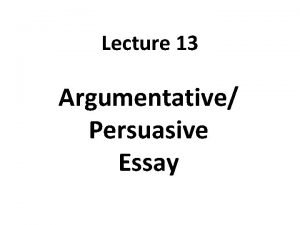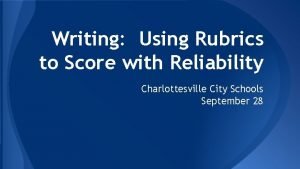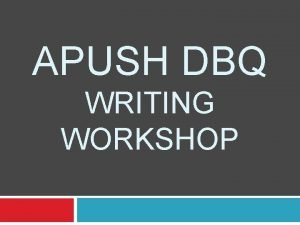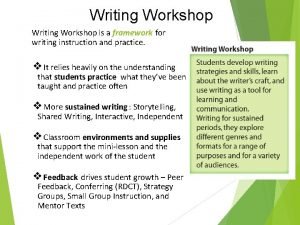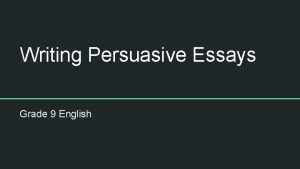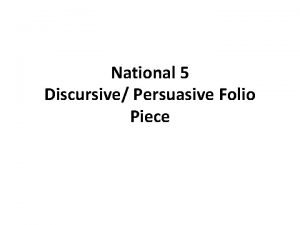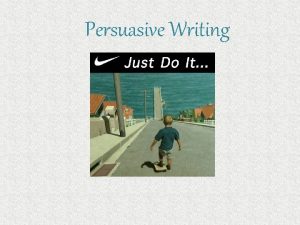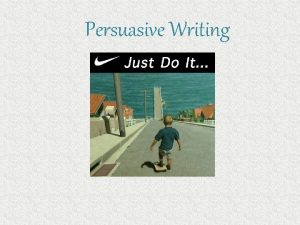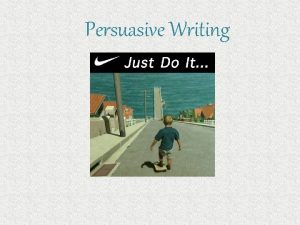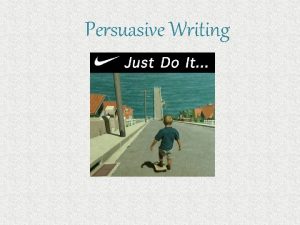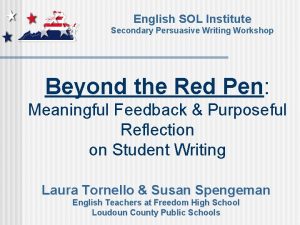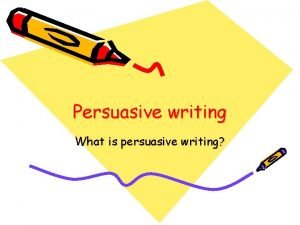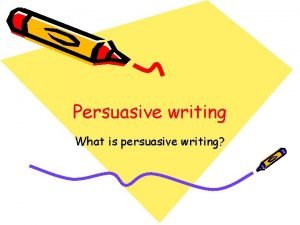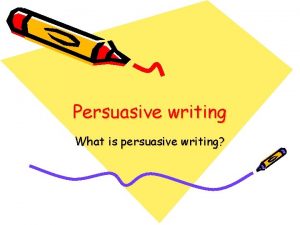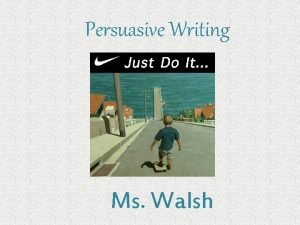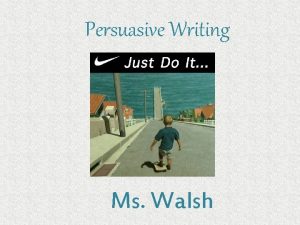English SOL Institute Secondary Persuasive Writing Workshop Christina


















- Slides: 18

English SOL Institute Secondary Persuasive Writing Workshop Christina Frierman-Teaching Consultant David Lacey-Teaching Consultant Tidewater Writing Project

Persuasive Writing Move students away from 5 paragraph, formulaic writing n Conferencing, guided writing, revising, sharing, and using mentor texts builds skills n Writing portfolios support student growth n K-12 English SOL Institute October 2013

Persuasive Writing Teach writing; don’t merely assign it n Teach peer revision/editing; putting students in groups is NOT teaching peer editing n Focus on purpose and audience n n Provide opportunities for students to change voice and audience K-12 English SOL Institute October 2013

Persuasive Writing Every piece of writing does not have to be graded! n Do incorporate writing into every lesson n Don’t correct every error in student papers n Use VDOE Resources including anchor sets and writing checklists n K-12 English SOL Institute October 2013

Instruction Anchor Sets K-12 English SOL Institute October 2013

Persuasive Writing Checklist n Add screenshot K-12 English SOL Institute October 2013

“THE LADY IN THE TOWER”

Materials n Materials in your packet: Story: “The Lady in the Tower” n 4 sheets of paper-different colors n “Did Too!” sheet (and on the back) n “Did Not!” sheet n Activity Instruction sheet (DON’T LOOK AT THIS YET) n

The Activity n Read the story as a class n On “Did Too!” sheet, write At least 1 reason for each character n Why is that character responsible n

The Activity n On the “Did Not!” sheet, write At least 1 reason for each character n Why the character is not responsible n n Rate the characters: 1 = Most responsible n 4 = Least responsible n Record numbers next to character’s names on “Did Too” n

The Activity. Small Group n Get into groups of 4 Volunteer A: Read aloud your “Did Too” reason for your most responsible character n Volunteer B: Read your “Did Not” for Volunteer A’s character and then read your “Did Too” for your number one, most responsible character. n Repeat until everyone has had a chance to debate n

The Writing Activity Choose 1 character you feel is the most responsible n Choose the paper color that matches that charactern King Henry = Purple n The Guard = Green n Princess Mary = Pink n Oliver Cromwell = Yellow n

The Writing Activity n Write a persuasive piece explaining why that character is most responsible n Audience = someone who blames a different character

The Writing Activity n Choose someone with a different color paper. n Exchange papers. n Read the other person’s rationale and write a response to his/her argument.

Writing the Essay Using your argument and the response to your argument, write the essay. n The essay must: n Make the case for the character you feel is most responsible n Respond to the criticism you received n Use evidence from the story n

Reflecting on the Process n Have students reflect on the process and answer the following question: What did you learn about the persuasive process from this activity?

Contact Information Tidewater Writing Project n Christina Frierman Virginia Beach City Public Schools n Christina. Frierman@VBSchools. com n n David Lacey Chesapeake City Public Schools n David. Lacey@cpschools. com n

Disclaimer Reference within this presentation to any specific commercial or non-commercial product, process, or service by trade name, trademark, manufacturer or otherwise does not constitute or imply an endorsement, recommendation, or favoring by the Virginia Department of Education. 18
 Koloid liofil
Koloid liofil Writing workshop: narrative writing quiz
Writing workshop: narrative writing quiz Persuasive vs argumentative
Persuasive vs argumentative Argumentative essay vs persuasive
Argumentative essay vs persuasive Sol writing rubric
Sol writing rubric Chapter 13: writing workshop -- résumés
Chapter 13: writing workshop -- résumés What does hipp mean apush
What does hipp mean apush Writing workshop framework
Writing workshop framework Business plan writing workshop
Business plan writing workshop Presentation
Presentation Proposal writing on career guidance workshop
Proposal writing on career guidance workshop Proposal writing on career guidance workshop
Proposal writing on career guidance workshop Persuasive writing grade 9
Persuasive writing grade 9 Released writing staar
Released writing staar Nat 5 persuasive essay examples
Nat 5 persuasive essay examples Eli gmu
Eli gmu King abdulaziz university english language institute
King abdulaziz university english language institute English language teaching institute
English language teaching institute Persuasive pronouns
Persuasive pronouns


